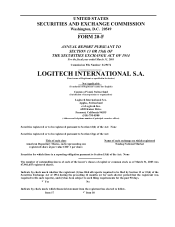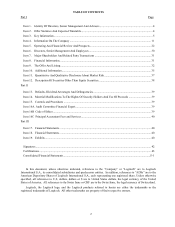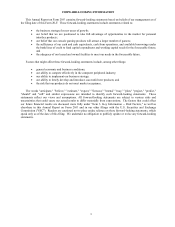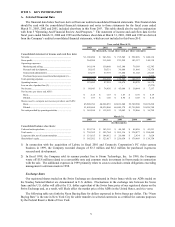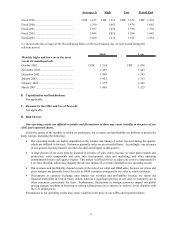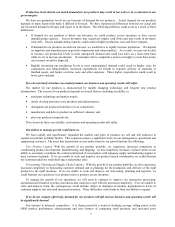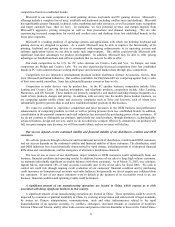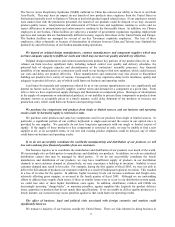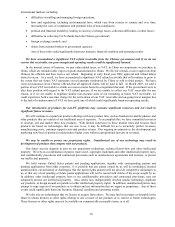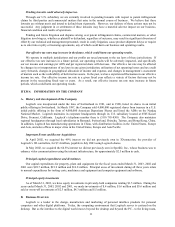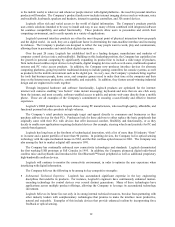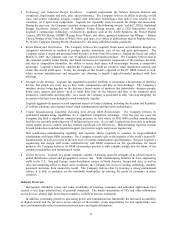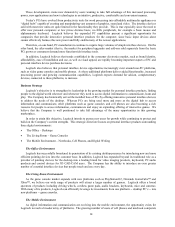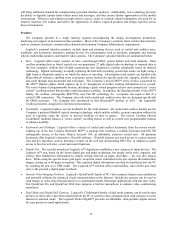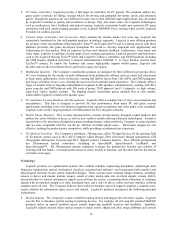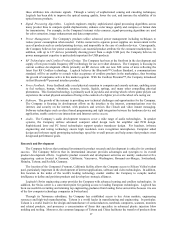Logitech 2003 Annual Report Download - page 112
Download and view the complete annual report
Please find page 112 of the 2003 Logitech annual report below. You can navigate through the pages in the report by either clicking on the pages listed below, or by using the keyword search tool below to find specific information within the annual report. 7
Production levels that do not match demand for our products may result in lost sales or in a reduction in our
gross margins.
We base our production levels on our forecasts of demand for our products. Actual demand for our products
depends on many factors that make it difficult to forecast. We have experienced differences between our actual and
our forecasted demand in the past and expect to in the future. The following problems could occur as a result of these
differences:
• If demand for our products is below our forecasts, we could produce excess inventory or have excess
manufacturing capacity. Excess inventory may negatively impact cash flows and may result in inventory
write-offs. Excess manufacturing capacity could result in higher production costs and lower margins.
• If demand for our products exceeds our forecast, we would have to rapidly increase production. We depend
on suppliers and manufacturers to provide components and subassemblies. As a result, we may not be able
to increase our production levels to meet unexpected demand and could lose sales on a short-term basis
while we try to increase production. If customers turn to competitive sources of supply to meet their needs,
our revenues would be impacted.
• Rapidly increasing our production levels to meet unanticipated demand could result in higher costs for
components and subassemblies, increased expenditures for freight to expedite delivery of materials or
finished goods, and higher overtime costs and other expenses. These higher expenditures could result in
lower gross margins.
If we do not timely introduce successful products our business and operating results will suffer.
The market for our products is characterized by rapidly changing technology and frequent new product
introductions. The success of our products depends on several factors, including our ability to:
• anticipate technology and market trends;
• timely develop innovative new products and enhancements;
• distinguish our products from those of our competitors;
• manufacture and deliver products in sufficient volumes; and
• price our products competitively.
If we do not do these successfully, our business and operating results will suffer.
Our failure to manage growth could harm us.
We have rapidly and significantly expanded the number and types of products we sell and will endeavor to
expand our product portfolio further. This expansion places a significant strain on our management, operational and
engineering resources. The areas that in particular are put under strain by our growth include the following:
New Product Launch. With the growth of our product portfolio, we experience increased complexity in
coordinating product development, manufacturing, and shipping. As this complexity increases, it places strain on our
ability to accurately coordinate the commercial launch of our products with adequate supply and marketing support to
meet customer demands. If we are unable to scale and improve our product launch coordination, we could frustrate
our customers and lose retail shelf space and product sales.
Forecasting, Planning and Supply Chain Logistics. With the growth of our product portfolio, we also experience
increased complexity in forecasting customer demand and in planning for the production and delivery of the right
products to the right locations. If we are unable to scale and improve our forecasting, planning and logistics, we
could frustrate our customers, lose product sales or produce excess inventory.
To manage the growth of our operations, we will need to continue to improve our transaction processing,
operational and financial systems, procedures and controls to cope with the increased complexity. If we are unable to
scale and improve them, the consequences could include: delays in shipment of product, degradation in levels of
customer support, lost sales and increased inventory. These difficulties could harm or limit our ability to expand.
If we do not compete effectively, demand for our products will fall and our business and operating results will
be significantly harmed.
Our industry is intensely competitive. It is characterized by a trend of declining average selling prices in the
OEM market, performance enhancements and new features of competing retail products, and increased price






